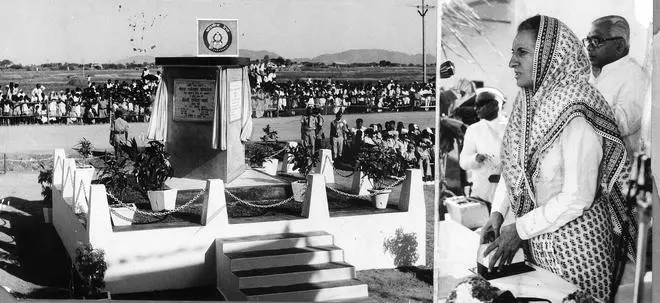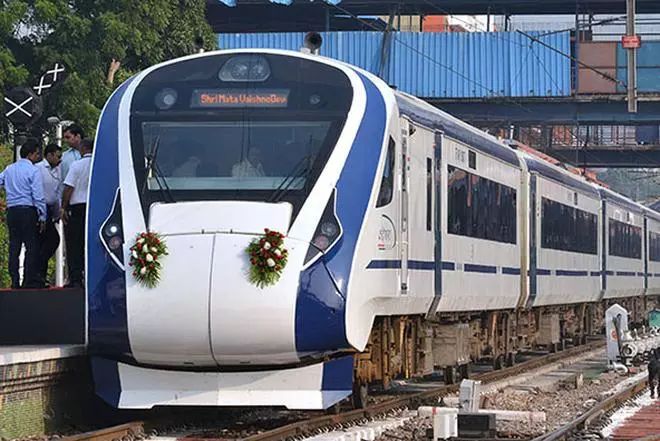Railways aren’t only about passengers, they are also about freight. The Indian railway system is one of the largest in the world. Depending on how you define a “train”, there are more than 13,000 passenger trains every day and almost 8,500 freight trains, and these trains traverse almost 7,500 stations. In some other major railway systems in the world, railways are primarily used for freight. That’s not true of India, partly because of the way railways have evolved historically.
The engine support frame of a diesel engine, at the “Diesel Locomotive Works”, in Varanasi | Photo Credit: S_ARNEJA
Notwithstanding the growth of civil aviation and road transport, railways remain the life-line for many passengers; many of whom travel unreserved. (The percentage depends on whether one is counting the local trains or not.) Because of this passenger focus, we often look at what’s happening to railways with that passenger lens.
The "Tobacco train", of 64 containers leaving Guntur, a town in the southern Indian State of Andhra Pradesh, for "Madras Port", from where the containers will be shipped for export. | Photo Credit: HINDU PHOTO ARCHIVES
In other sectors, as consumers, we have benefited from liberalisation and the resultant competition and efficiency. Why should that not happen for railways too? Why can’t we have railway stations comparable to stations in the rest of the world? Why can’t the railway stations be like airports? We will soon have such modern stations in Habibganj (Bhopal), Gandhinagar and Bijwasan (Delhi). At some point, Nagpur, Gwalior, Amritsar, Sabarmati, Shivajinagar, Surat, Baiyyappanahalli, Gandhinagar (in Jaipur), Kanpur, Thakurli, Anand Vihar (Delhi) and Chandigarh will follow.
Much needed changes

(Left): Inauguration of the South Central Railways' Rs. 15 crore- wagon repair workshop project at Vijayawada, an important pilgrim town in the southern Indian State of Andhra Pradesh. (Right): Smt. Indira Gandhi, Prime Minister of India, pressing the button to unveil the plaque at the project site near Rayanapadu. L. N. Mishra, Minister for Railways (standing behind her) and K. Brahmananda Reddy, Minister for Communications are also seen in the picture. | Photo Credit: HINDU PHOTO ARCHIVES
But we must remember, change doesn’t happen overnight. The legacy of several decades cannot be overcome at the stroke of a pen. Change is always incremental and, there is a timeline. Indeed, there is a template for change. There is a National Rail Plan, that will serve as a vision document for 2030. Earlier, there was the Debroy Committee Report in which we focused on five major strands — (A) Decentralisation of decision-making; (B) HR changes, to break down silos; (C) A regulator, to ensure fair competition between private players and the public sector entity (which will continue to run trains); (D) Modernisation of accounts; and (E) Private entry.
Indian railways (IR) is divided into zones and divisions. Unnoticed to many of us who use that lens as passengers, and are less concerned about operational matters, a lot of decentralisation has occurred since 2014 (actually 2015), with decisions delegated downwards to general managers and divisional railway managers . Not only was there excessive decentralisation over time, down the years, with a large number of services, IR operated in silos.
Our primary recommendation under (B) was to unify Group A services through the Indian Railways Management Service (IRMS). This is easier done prospectively. There are more complicated issues when one tries to adapt the new system retrospectively, with messy seniority problems. A major change like this requires intensive discussions, plus there was the pandemic. Post-Covid, the new IRMS (recruited through UPSC) has just been announced.
Privatisation v Private entry
People often use the word “privatisation” irresponsibly, without explaining what they mean. There is track and related infrastructure. IR is so integrated vertically that, it is virtually impossible, and unnecessary, to dismantle and privatise track and related infrastructure. Countries that have tried to do that haven’t necessarily succeeded. Hence, one should use the expression private entry, which allows for competition and the consequent efficiency.
When one boards a train, most services are already privatised. When one passes through a station, most services are already privatised. The more visible aspect of this is of course that of the private sector running trains. In other words, track is publicly owned, and both IR and the private sector run trains on this common track, with access problems sorted out. Post-Covid, a private Bharat Gaurav train has now started, and there will be more. To ensure that the rules of competition are fairly implemented between the private and the public, we of course need a regulator.
That regulator can also recommend tariffs. If we want better trains, better services, and better stations, we must be prepared to pay more. A perennial problem has been artificially low passenger fares, and these are cross-subsidised by artificially high freight costs. To state it bluntly, our figures (at the time of the Committee) were that, to subsidize one passenger train, one needed to run one and a half goods trains.
All of us would like faster trains and there are several high-speed corridors in the offing, with Mumbai-Ahmedabad the most visible and the earliest to be completed. But others are planned. There is the related matter of dedicated freight corridors, which also free up tracks for use by passenger trains, enabling faster travel. (In both such cases, as with several physical infrastructure projects, land must be acquired.) Stations, and comparing them to airports, is a good example to make a different point. Can stations be built by the private sector (Delhi and Mumbai airports)? That depends on whether the land is available, and can be monetized. Therefore, it is good to bear in mind IR’s plans in the National Monetization Pipeline.

A view of the Vande Bharat Express train, which will be running from New Delhi Railway Station to Vaishno Devi, Katra, Jammu. Katra is the last station on the way to famous Hindu pilgrimage Vaishno Devi, The Vande Bharat Express will reduce the journey time between Delhi and Katra by eight hours in New Delhi. | Photo Credit: MOORTHY RV
In sum, these are exciting times for the IR. They are also challenging times, since IR is at a cusp, and expectations are high.







Comments
Comments have to be in English, and in full sentences. They cannot be abusive or personal. Please abide by our community guidelines for posting your comments.
We have migrated to a new commenting platform. If you are already a registered user of TheHindu Businessline and logged in, you may continue to engage with our articles. If you do not have an account please register and login to post comments. Users can access their older comments by logging into their accounts on Vuukle.